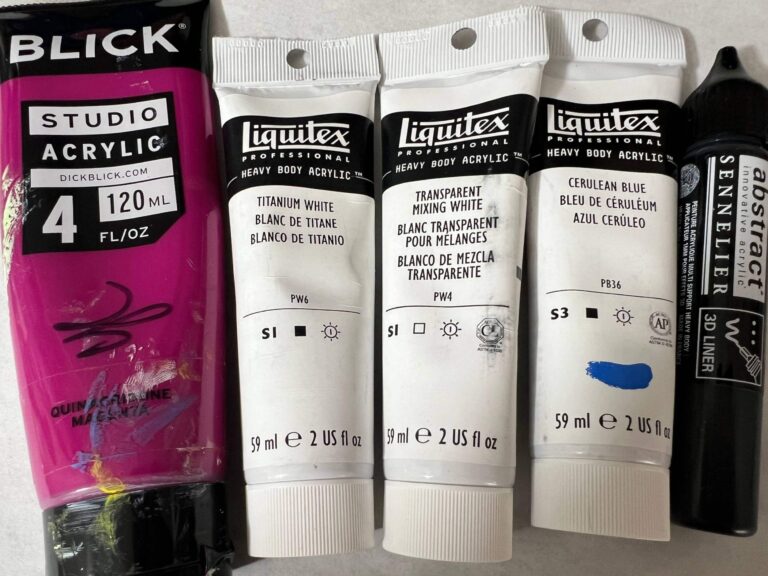Titanium White vs Mixing White
I’ve only recently begun mixing colors. For the first several years of my mixed media art life, I bought the exact colors I wanted. Consequently, I have a banker’s box full of heavy-body paints and a ton of Golden fluid acrylic paints, too. But recently, I’ve begun to see the beauty and versatility of a limited color palette of red, yellow, blue, black, and white when painting with acrylics.
When I was looking for the ideal white to go with my primary colors, I ran across titanium white and mixing white; I wasn’t sure what the difference was, so I decided to find out. I ordered a tube of each and started swatching!

The Process
I used pages from an old book so I could get a better idea of the relative transparencies of the colors mixed with the two whites. When mixing the colors, I used approximately an equal amount of the color and the white. I made a concerted effort not to mix a little white with one and a lot of white with the other sample! I mixed white to color at about a 1:1 ratio.
The paints I used were varied. I wanted to see how the whites mixed with different qualities of paints.
Using book pages for the substrates allowed me to see the difference in transparency/opacity between the two whites, and the original swatches next to the mixed swatches.

The Whites
The two whites I chose for this experiment were Liquitex Professional Heavy Body Acrylic Titanium White and Liquitex Professional Heavy Body Acrylic Mixing White. I wanted to use the same brand for the best comparison, so that I was comparing apples to apples (or white to white, as the case may be).
The titanium white is definitely the more opaque of the two. It has excellent coverage and can be used for highlights, tints, and distinct layers.
The mixing white (sometimes referred to as ‘zinc white’) is more transparent. It’s perfect for creating subtle tints, glazes, and for mixing colors without making them too opaque.
Without mixing them with any other colors, I could see that the titanium white is, indeed, more opaque than the mixing white on the book paper. That’s not surprising, since the transparency ratings on the tubes are different. The mixing white by itself also looks a tiny bit brighter than the titanium white.

Cerulean Blue
The first color I chose to mix with was Liquitex Professional Heavy Body Acrylic Cerulean Blue. The blue mixed with the titanium white is much lighter, more opaque, and has a chalkier appearance than the blue mixed with the mixing white. The blue mixed with the mixing white is truer to the original color, just less saturated.

Quinacridone Magenta
Quin Magenta is a color I used to use a lot, before I started learning to mix my own colors. It’s an old favorite of mine. I rummaged around in my box and found a tube of Blick Studio Acrylic Quinacridone Magenta.
The results were just what I expected. The quinacridone magenta mixed with the titanium white looks heavier than the paint mixed with the mixing white. The mixing white sample is also brighter and more transparent. Again, the magenta mixed with the mixing white is not as light as the sample mixed with the titanium white, though the difference between the two tints is not as obvious.

Mars Black
The last color I tested was Sennelier Abstract Innovative Acrylic Mars Black. This was not a simple repeat of the other two tests!
Mars black is not only very dark, but not surprisingly, it’s also very opaque. In the sample, you don’t see any of the text paper showing through. The paint mixed with the titanium white is a very dark gray – I expected this – and there’s no transparency to it at all. Again, not surprising, since I mixed two opaque colors together.
But what was surprising to me is that the mixing white barely changed the mars black! In fact, if I look at the swatches straight on, I see almost no difference at all; I have to hold the swatches at an angle to see much difference than the mars black by itself. The sample tinted with mixing white is a teeny bit more transparent and a little duller.
Conclusion
So, do you need both titanium white and mixing white?
That, of course, depends on your personal preferences and your budget, but I’d suggest investing in a tube of quality mixing white if you can. One of the reasons I always bought paints – especially pastels and lighter colors – is that I could never mix a light one without it looking chalky or washed out. Now I understand why.
I’m going to keep a tube of mixing white in my arsenal – but I’m not going to stop buying beautiful colors that catch my eye!


